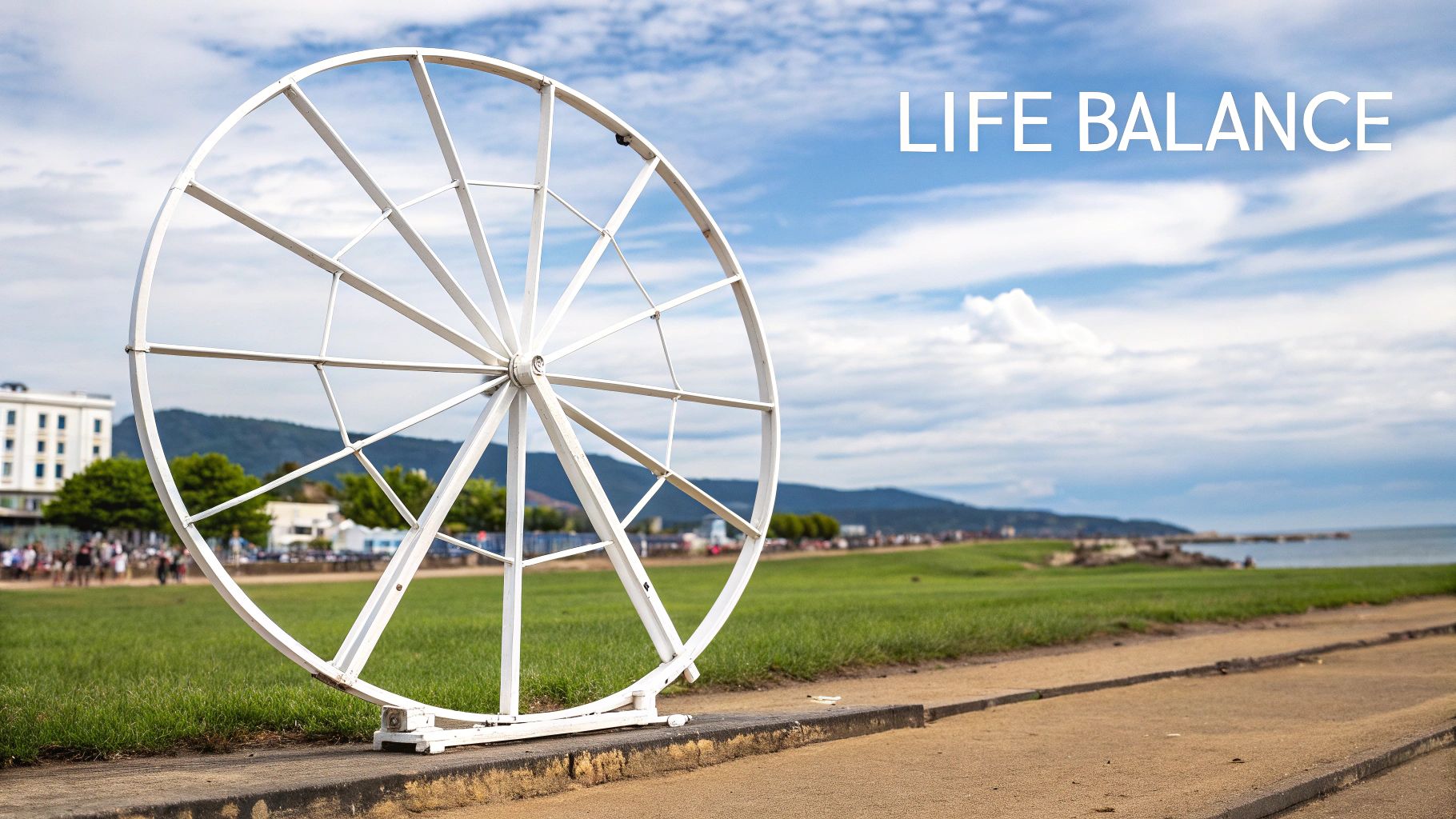Understanding the Wheel of Life: Your Map to Balance
The wheel of life is a handy tool to help you visualize your overall sense of balance and fulfillment. Think of it as a snapshot of how satisfied you are with different parts of your life. It helps highlight your strengths and pinpoint areas where you might want to grow. This simple circle can bring a clarity that traditional self-assessments often miss, letting you see, at a glance, which areas are thriving and which could use a little more TLC.
Why the Wheel of Life Matters
The wheel of life helps you identify specific areas that might be contributing to stress, dissatisfaction, or even burnout. For example, you could be rocking it professionally, but neglecting your physical health or relationships with loved ones. Over time, these imbalances can become bigger issues. Interestingly, the Wheel of Life concept was introduced by Paul J. Meyer back in the 1960s as a tool for self-evaluation and goal setting. Since then, it’s become a popular method for assessing life balance across categories like work, health, relationships, and personal growth. Want to learn more about its history? Check out this article: The Wheel of Life at Work.

The wheel of life also serves as a great starting point for making positive changes. You can create a personalized roadmap to achieve greater balance and fulfillment by clearly seeing areas needing improvement. Instead of feeling overwhelmed by a general sense of unease, you can focus your energy on specific, achievable steps. For some tips on creating positive habits, you might find this article helpful: Why Rituals Work.
How the Wheel Works
The wheel of life is usually divided into 8-10 key areas representing different aspects of your life. You can customize these categories to match your own values and priorities. Some common categories include:
- Career: How satisfied are you with your professional life and work?
- Finances: How secure and stable do you feel financially?
- Health: How would you rate your physical and mental well-being?
- Relationships: How fulfilling are your connections with family and friends?
- Personal Growth: Are you continuing to learn and grow as a person?
- Fun & Recreation: Do you make time for hobbies and leisure activities?
- Environment: Are you happy with your physical surroundings and living space?
- Contribution: Do you feel a sense of purpose and giving back to the community?
Each area is rated on a scale of 1 to 10, with 1 representing very low satisfaction and 10 being completely fulfilled. By connecting the dots, you create a visual representation of your current life balance – it’ll look a bit like a spiderweb. The more balanced your life, the more circular your wheel. Low scores create dips in the wheel, highlighting imbalances that might need some attention. This visual format makes it easy to see which areas could benefit from some focus.
Creating Your Personal Wheel of Life Blueprint
Creating a Wheel of Life isn’t about using a pre-made template. It’s about designing a personal blueprint that truly reflects your own priorities and values. This means carefully choosing categories that genuinely resonate with you. Avoid including areas you think should be important, but that don’t actually contribute to your overall sense of fulfillment. This personalized approach makes the wheel a powerful tool for self-discovery, not just a checklist of societal expectations.
Choosing Your Categories
Traditional wheels often include categories like career, finances, and health. But think outside the box! Perhaps “Creative Expression” or “Community Involvement” means more to you than career advancement. Consider what truly energizes you and brings you joy. This personalized approach ensures the insights are relevant and actionable. For example, if environmental sustainability is a core value, include it! Creating your personal Wheel of Life blueprint can be part of a journey of self-rediscovery and finding inner balance. For some helpful tips, check out these suggestions on reconnecting with yourself.
Honest Self-Assessment
One of the biggest mistakes is not being honest with yourself during the self-assessment. Many people overestimate their scores to avoid uncomfortable truths. But the real value of the wheel comes from honest reflection. This isn’t about self-criticism; it’s about getting a clear understanding of where you stand. The Wheel of Life typically divides life into 6 to 10 key areas, depending on the model. You evaluate your current satisfaction in each area on a scale of 1 to 10, making it easy to see where you might want to focus on improvement. The Wheel of Life offers a helpful framework for this process.
To help you brainstorm, here’s a table comparing common Wheel of Life categories:
Common Wheel of Life Categories
| Life Category | Description | Example Rating Questions |
|---|---|---|
| Career | Professional growth and fulfillment | How satisfied are you with your career path? Do you feel challenged and engaged at work? |
| Finances | Financial security and stability | Do you feel secure in your current financial situation? Are you working towards your financial goals? |
| Health | Physical and mental well-being | How would you rate your overall physical health? Do you feel mentally and emotionally balanced? |
| Relationships | Connections with family and friends | How fulfilling are your relationships? Do you feel supported and loved? |
| Personal Growth | Learning and self-improvement | Are you pursuing activities that contribute to your personal growth? Do you feel you are learning and evolving? |
| Fun & Recreation | Leisure activities and hobbies | Do you make time for fun and enjoyable activities? Do you feel a sense of playfulness and joy? |
| Spirituality | Connection to a higher purpose | Do you feel connected to something greater than yourself? Do you have a sense of meaning and purpose? |
| Physical Environment | Your home and surroundings | Are you happy with your living space? Do you feel comfortable and at peace in your environment? |
This table provides a starting point. Remember, your wheel should reflect what truly matters to you.
Visualizing and Interpreting Your Wheel
After rating each area, connect the dots to visualize your wheel. The irregular shape will immediately reveal any imbalances. But don’t just look at the low scores. Consider the relationships between the categories. For example, a low score in “Health” might be related to low scores in “Fun & Recreation” or “Stress Management.” These connections offer valuable clues about the root causes of imbalance and help you develop more effective strategies for positive change. If you’re looking to improve your goal-setting skills, this resource on goal setting could be helpful.

Understanding these connections is key to creating a life that feels balanced and fulfilling.
Decoding Your Wheel: Patterns That Reveal Everything
Your completed wheel of life isn’t just a pretty picture; it’s a dynamic snapshot telling a story about where you’re at right now. It’s not just about finding the low scores, but about seeing how each area of your life connects and influences the others. This deeper understanding transforms the wheel of life from a simple exercise into a powerful tool for personal growth.
Beyond the Obvious: Unveiling Hidden Connections
Low scores clearly show areas needing some TLC, but focusing only on those can sometimes do more harm than good. Imagine putting all your energy into boosting your career while neglecting your health. It might seem like a good strategy at first, but eventually, burnout could hit, impacting your career anyway. Experienced coaches know that real growth comes from finding strategic starting points. These are the areas where improvements have a ripple effect, positively influencing other parts of your life. It’s about looking beyond the obvious and understanding the interconnectedness of everything.
The Four Classic Wheel Shapes
Experts have identified four common wheel shapes, each reflecting a different approach to life:
- The Spiky Wheel: Highs and lows are the hallmarks of this wheel. It shows intense focus in some areas and neglect in others, often leading to feeling stretched thin and constantly reacting to crises.
- The Low-Level Wheel: Consistently low scores across the board suggest a general lack of satisfaction. If this is your wheel shape, a more holistic approach to self-improvement might be beneficial.
- The High-Level Wheel: High scores across most areas reflect overall contentment. However, watch out for complacency! It can stifle growth and potentially lead to future dips in satisfaction.
- The Balanced Wheel: This is the ideal shape, showing a well-rounded life with good satisfaction across all areas. This balance helps you stay resilient and sets the stage for sustainable personal growth.
Identifying your wheel shape provides valuable insight into your current approach to life and highlights areas with potential for growth.
From Dips to Chronic Imbalances: Knowing When to Intervene
A temporary dip in one area, like feeling stressed due to a big project at work, isn’t the same as a chronic imbalance. The wheel of life helps you tell the difference. Looking at past wheels can reveal patterns and pinpoint areas where you consistently struggle. This historical perspective is incredibly helpful for understanding the root causes of your imbalances and finding long-term solutions. Recognizing these patterns is crucial for achieving lasting balance and fulfillment.
Recognizing Cascading Failures
Sometimes, seemingly unrelated areas of your wheel are connected in surprising ways. For example, neglecting your social life can lead to feelings of isolation, impacting your mental well-being, and eventually affecting your work performance. Recognizing these hidden connections—what we call cascading failures—is essential for understanding the intricate dynamics within your wheel of life. By understanding these connections, you can develop effective strategies for positive change. This holistic approach is key for sustainable growth and overall well-being.
Turning Wheel Insights Into Action

Creating a wheel of life is a powerful first step. However, the real magic happens when you transform those insights into positive changes. This can be tricky, and many people struggle to bridge the gap between awareness and action. This section explores practical strategies to build an action plan that works, using principles of behavioral psychology and the success stories of countless wheel of life users.
Why Traditional Goal-Setting Fails (And What To Do Instead)
Typical goal-setting often misses the mark with the wheel of life. It tends to focus on individual targets, ignoring the interconnectedness of life’s different areas. This can lead to focusing too much on one aspect while neglecting others. It’s like trying to fix a leaky faucet while the whole plumbing system needs an overhaul. Successful wheel of life users take a different approach. They focus on a keystone habit – a central behavior that creates positive ripple effects across multiple areas. For example, improving your sleep can boost your energy, focus, and even your relationships.
The Power of Quick Wins
Building momentum is key for long-term success. A great way to do this is by identifying quick wins. These are small, achievable actions that give you a sense of accomplishment and keep you motivated. These wins can be surprisingly simple. Think decluttering your workspace or spending 15 minutes a day on a hobby. These small victories create a positive feedback loop, making it easier to tackle bigger challenges down the line. Visually representing life’s segments helps you set specific goals and develop action plans for improved balance and well-being. Learn more: The Wheel of Life at Work.
Sequencing Your Improvements: A Counterintuitive Approach
Rather than tackling your lowest score first, try focusing on an area that’s slightly higher but still needs work. This approach helps you build confidence and create a positive cycle of change. This success then gives you the momentum to tackle more challenging areas with renewed resilience and motivation. You might find this interesting: 5 Ways to Create a Personalized Customer Journey.
Maintaining Accountability: Systems That Work
Motivation naturally ebbs and flows. That’s why accountability systems are essential. Find an accountability partner, join a support group, or use a habit-tracking app. Regularly reviewing your wheel of life and adjusting your action plan is also crucial. This continuous reflection and adaptation is what separates lasting change from temporary fixes. These straightforward strategies keep you on track, even when things get tough.
Addressing Multiple Areas Without Burnout
Working on multiple areas of your wheel of life shouldn’t lead to burnout. Prioritize 2-3 key areas at a time. Set realistic goals and break them down into smaller, manageable steps. This focused approach prevents you from feeling overwhelmed and allows you to make steady progress. Remember, real, lasting change is a marathon, not a sprint.
Evolving Your Wheel: The Continuous Growth Cycle

The wheel of life is a powerful tool for personal growth, not just a one-time exercise. Think of it as your personal GPS, guiding you toward a more balanced and fulfilling life. Regularly checking in with your wheel helps you identify small shifts before they become major obstacles.
Finding Your Rhythm: How Often Should You Reassess?
The best rhythm for reviewing your wheel depends on you and what’s going on in your life. During times of big changes, like starting a new job or navigating a major life transition, a monthly check-in can be incredibly helpful. For example, if you’re launching a business, regular reviews help ensure you’re not neglecting other important areas of your life. During calmer periods, a quarterly review might be enough. This consistent assessment allows you to catch any imbalances as they emerge and make adjustments.
Tracking Progress Without Obsession: The Art of Accurate Self-Reflection
It’s tempting to strive for a perfect 10 in every area of your wheel of life. However, that’s not the point. True progress comes from honest self-reflection and accepting where you are right now. Life is constantly changing, and your scores will naturally fluctuate. Don’t be discouraged by temporary dips. Instead, focus on the overall direction. Are your scores generally trending upwards? That’s a great sign! The wheel of life is now a global tool used across many cultures and industries. Learn more about the global reach of the wheel of life.
Journaling for Deeper Insights: Unlocking the Power of Written Reflection
Journaling can supercharge your wheel of life experience. After each assessment, spend a few minutes writing about your scores. What factors influenced your ratings? What steps can you take to improve? This will help you uncover deeper insights and create more effective action plans. Looking for ways to manage stress? You might find this article helpful: How to Reset a Stressed Life.
Visualization and Commitment: Strengthening Your Intention for Change
Visualization can strengthen your commitment to change. Picture your ideal wheel. What does it look like? How does it feel? Connecting with this vision boosts your resolve and motivates you to take action. Visualization transforms abstract goals into tangible desires, pushing you toward positive change.
Adapting Your Wheel: Navigating Life’s Transitions
Your wheel of life isn’t set in stone. It should change as your life does. During significant transitions, like a career change or starting a family, re-evaluate your categories. Are they still relevant to your current life? Do you need to add or remove any areas? This flexibility ensures your wheel remains a valuable tool for self-reflection and growth.
Celebrating the Journey: Recognizing Growth and Patterns
Looking back at your previous wheels is a great way to celebrate your progress. It helps you appreciate how far you’ve come and spot any recurring patterns. Understanding these patterns is essential for continued growth and helps you make conscious choices that align with your values and goals. By regularly reviewing your wheel of life, you’ll gain valuable insights into your personal journey and empower yourself to create a life that truly reflects your aspirations.
Beyond Personal Growth: Wheel of Life in Every Context
The wheel of life isn’t just for personal development. It’s a flexible tool useful in many different areas, from improving employee well-being to building stronger relationships and navigating big life changes. This adaptability shows how powerful the wheel is for finding balance in any part of life.
Revolutionizing the Workplace
Smart companies are using the wheel of life to improve employee well-being programs and develop their leaders. It’s not about offering trendy perks, but about building a supportive and positive work environment. The wheel helps organizations see where employees might be struggling, such as work-life balance or career growth, and create programs to address these needs. This can lead to better employee retention and performance, benefiting everyone involved.
Strengthening Relationships With the Wheel
Relationship counselors are using the wheel of life to help couples resolve conflicts and find common ground. Each partner creates their own wheel, then they discuss their wheels together. This helps them understand each other’s needs and perspectives, leading to better communication and a stronger relationship. A comfortable and well-organized personal space can contribute to overall well-being, impacting other areas of the wheel. Check out this guide on creating a relaxing bedroom: How to Declutter Your Bedroom: The Ultimate Guide to Creating Your Perfect Sleep Sanctuary.
Customized Wheels for Career Coaching
Career coaches are adapting the wheel of life for different professions and career stages. A wheel for someone just starting out might focus on skill-building and networking, while a wheel for someone nearing retirement might focus on finances and leisure activities. This personalized approach helps people at all career stages gain focus and plan for their professional goals.
Navigating Life’s Disruptions
Wellness professionals are using the wheel of life to support people through recovery and major life changes. When clients face big challenges, the wheel provides structure and a path forward. It helps break down complex problems into smaller, more manageable pieces, offering a sense of control during difficult times. The growing use of the wheel of life in coaching, seen in many personal development programs and business coaching techniques, shows its effectiveness. It provides a visual and interactive way to find balance and set achievable goals. Learn more about this here: The Wheel of Life as a Tool for Growth.
Effectiveness Across Contexts
To understand the versatility of the wheel of life, let’s look at the table below. It explains how the wheel can be used in different situations and the benefits it offers.
| Application Context | Primary Benefits | Common Adaptations | Success Indicators |
|---|---|---|---|
| Workplace Wellness | Increased employee engagement, improved productivity, better retention rates | Focus on work-life balance, stress management, professional development | Reduced burnout, higher employee satisfaction, improved performance metrics |
| Relationship Counseling | Improved communication, conflict resolution, shared understanding of needs | Separate wheels for each partner, joint discussion of results | Increased empathy, stronger emotional connection, reduced conflict |
| Career Coaching | Career clarity, goal setting, action planning | Tailored categories for specific industries and life stages | Increased job satisfaction, career advancement, achievement of professional goals |
| Wellness & Recovery | Structured path forward, improved coping mechanisms, increased self-awareness | Focus on emotional regulation, healthy habits, self-care practices | Reduced stress, improved well-being, successful navigation of life transitions |
As you can see, the wheel of life is a versatile and powerful tool for finding balance and fulfillment in every area of life.
Ready to build a more balanced life? Visit Lorelei Web for helpful advice and tools to improve your personal and professional life. We offer many resources, including articles on productivity, goal setting, and personal growth, all designed to help you take control of your wheel of life and create the life you want.

Lorelei has been an online entrepreneur, marketer and writer since 2006. Her biggest passion is WordPress, which is why she switched to being a full-time blogger 20 years ago and hasn’t looked back since. With so many years of experience behind her, she is an expert in copywriting, SEO, marketing and business strategies.






